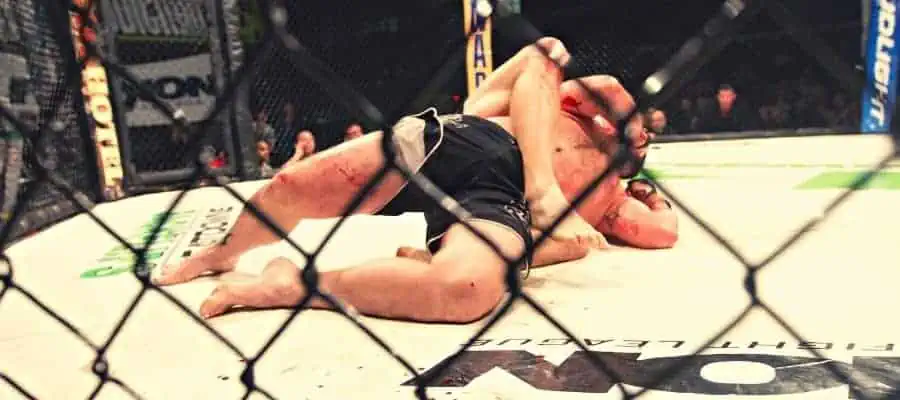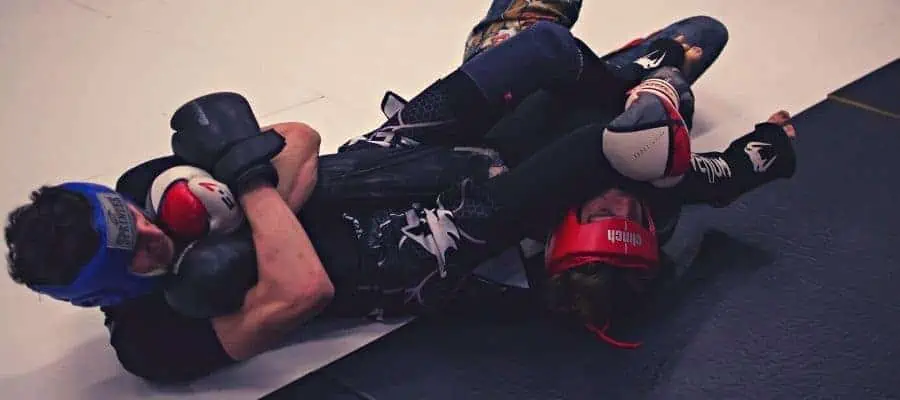In the world of mixed martial arts (MMA), the question of whether weight matters is a topic of ongoing debate. With fighters divided into weight classes, it’s clear that size plays a role in competitive matchups. However, the extent to which weight truly impacts a fight’s outcome is less clear-cut.
So, how big of a role does weight play in MMA? Weight matters in MMA, as it can provide certain power, strength, and size advantages. However, it is not the sole determinant of success, as technique, strategy, and other physical attributes also play a significant role in a fighter’s performance.
We all know weight is one of the major factors in all combat sports, but many factors related to weight are rarely considered. For example, how big of an advantage does weight have in the same weight class? And in which weight classes is the weight advantage more pronounced?
The Role of Weight In MMA

A fighter’s weight can give them a size advantage, increasing power, strength, and reach. This can make it tough for lighter opponents to defend against their strikes or counter their moves, especially when the heavier fighter is on the ground. Additionally, a larger fighter with longer arms can use their reach to land hits from a safe distance.
Most MMA organizations have weight classes to ensure fair and competitive fights. Fighters have to meet the weight limit for their division, which helps even out differences in size. Even though size can still matter, fighters in the same weight class are generally more closely matched, so technique and strategy become more important.
While weight can be helpful, a fighter’s success is mostly decided by their technique and strategy. Skilled fighters can defeat bigger opponents by employing striking, grappling, and submission techniques. Furthermore, their speed, agility, and endurance can make up for any weight disadvantage.
The Importance of Weight Management in MMA
In MMA, it is important to maintain a healthy weight due to the strict weight class regulations that fighters must adhere to. Meeting the weight requirements of their respective divisions is crucial for athletes to ensure fairness and competitiveness during matches. This requires following a balanced diet, regular exercise, and a careful weight cut before fights.
If a fighter does not meet the weight limit, they may be penalized by losing a portion of their fight earnings or being disqualified from the match. Moreover, fighters who frequently face weight problems may find it difficult to schedule future fights or advance in their careers since promoters may be reluctant to engage them for fear of last-minute cancellations.
Fighters must balance weight management with maintaining their physical performance and energy levels. While trying to quickly lose weight, extreme measures such as dehydration or crash dieting may harm their strength, endurance, and overall health. Hence, it’s crucial for them to effectively manage their weight throughout their training camps to avoid any negative impact on their performance during the fight.
In addition to performance, managing weight is crucial for a fighter’s overall health. Extreme weight cutting can cause damage to the body, including kidney problems, hormonal imbalances, and a weakened immune system. It can also affect mental well-being due to the stress of making weight, which can lead to anxiety and depression. By adopting a sustainable approach, fighters can prioritize both short-term performance and long-term health.
Fighters use different strategies to manage their weight for a fight based on their body composition, metabolism, and preferences. Some prefer gradual weight loss, while others may need more aggressive methods in the weeks before the fight. Fighters must consult with a qualified nutritionist, strength and conditioning coach, or sports medicine professional to create personalized and safe weight management plans.
Notable Examples of Smaller Fighters Overcoming Weight Disadvantages

Royce Gracie
In the early days of the UFC, Royce Gracie (who most of you should know by now) was a smaller fighter who was an expert in Brazilian Jiu-Jitsu and defeated much larger opponents who outweighed him. He used his superior grappling techniques and submission game to neutralize their size advantage, which helped him win several UFC titles. Gracie’s success showed that Brazilian Jiu-Jitsu was effective and that technique could overcome size in MMA.
Demetrious Johnson
Another standout example is Demetrious “Mighty Mouse” Johnson, who reigned as the UFC Flyweight Champion for six years. Although Johnson is one of the smaller fighters in the promotion, his exceptional technique, speed, and fight IQ allowed him to dominate his weight class and solidify his status as one of the greatest MMA fighters ever. Johnson’s ability to seamlessly blend striking and grappling and his impressive conditioning enabled him to overcome larger opponents in catchweight or open-weight fights.
Frankie Edgar
Frankie Edgar’s run as the UFC Lightweight Champion is an example of a smaller fighter overcoming size disadvantages. Often considered undersized for the lightweight division, Edgar relied on his wrestling, striking, and cardio to outwork his opponents. His most notable victories include defeating the larger and more powerful BJ Penn twice and Gray Maynard in a thrilling trilogy. Edgar’s success showcases the importance of technical proficiency and heart in overcoming size disparities.
Does Weight Matter More in Heavier or in Smaller Weight Classes?

In the heavier weight classes, the difference in weight between fighters can be more pronounced. For instance, the heavyweight division has a wide range of allowable weights, from 206 to 265 pounds. This means a fighter weighing 206 pounds could face an opponent who outweighs him by almost 60 pounds.
The size and power advantages that come with the additional weight can be significant and often lead to more knockout victories in heavier weight classes. In these divisions, fighters rely more on their striking power and durability, as a single well-placed punch or kick can end a fight instantly.
On the other hand, fighters in lighter weight classes usually have smaller weight gaps between them. As a result, they use their speed, agility, and techniques to outperform their opponents. Although knockout power is still important, smaller fighters tend to have a wider range of skills, such as striking, grappling, and submissions. Their matches are typically more technical and fast-paced due to their speed and accuracy, emphasizing strategy and skill more than strength.
Weight can affect the outcome of a fight differently depending on the weight class and the fighters’ skills. Bigger weight classes often give larger and stronger fighters an advantage, resulting in more knockouts. Smaller weight classes prioritize technique, speed, and agility overweight, making it less crucial in determining the outcome.
The Problem with Weight Bullies
“Weight bullies” is a term used for fighters who lose a significant amount of weight to compete in a lower weight class, which allows them to have a size and strength advantage over their opponents. These fighters are larger than their competition but artificially reduce their weight to compete in a lower class. This can negatively impact MMA as it may result in fewer competitive and entertaining fights, as the “weight bullies” have an unfair advantage.
Now, why are weight bullies frowned upon? Well, for one, it’s considered unsportsmanlike. Fighters should ideally compete at their natural weight so they’re facing opponents with similar sizes and skill levels. When weight bullies use extreme weight-cutting measures, they’re not showing respect for the spirit of the sport. Plus, the health risks involved with drastic weight cutting are no joke. Fighters can experience severe dehydration, muscle loss, and long-term kidney and liver damage.
There have been several fighters in the history of MMA who have been accused of being weight bullies. One example is Anthony “Rumble” Johnson, who used to compete as a welterweight but struggled to make weight on multiple occasions. Despite his size advantage at welterweight, the extreme weight cut took a toll on his performance, and he eventually moved up to light heavyweight and even heavyweight, where he found more success.
Gleison Tibau, a lightweight fighter, was also known for being unusually big for his weight class. He achieves this by cutting a significant amount of weight, which gives him an advantage over opponents. However, many people, including fans and other fighters, have criticized this practice. In contrast, some fans simply see it as something that comes with the territory.
What are the Most Significant Weight Class Differences in MMA History?

Back in the early days of MMA, weight classes were fewer and had fewer regulations. This caused significant weight differences in matchups that are hard to imagine today. The fight between Keith Hackney and Emmanuel Yarbrough at UFC 3 in 1994 is an example of such a matchup. Yarbrough, a 600-pound sumo wrestler, fought against Hackney, who was only around 200 pounds. Despite the 400-pound difference, Hackney won the fight with his speed and striking abilities.
At the K-1 World Grand Prix in 2002, Bob Sapp, who weighed 370 pounds, fought against Ernesto Hoost, a four-time K-1 World Grand Prix Champion who weighed 205 pounds. Despite being smaller, many believed that Hoost’s superior skills and experience would be enough to defeat Sapp.
Nevertheless, Sapp’s immense size and power proved to be too much for Hoost, and Sapp won by TKO. This outcome demonstrated that size and power can play a significant role in a fight, especially if the opponent is less skilled but physically dominant.
However, as the sport has evolved and fighters have become more well-rounded, technique and skill have become increasingly important factors in determining the outcome of a fight.
How Does a Fighter Choose the Right Weight Class for Their MMA Career?

For MMA fighters, selecting the appropriate weight class is crucial for their performance and career path. They should evaluate their body type, fighting style, and natural weight, as well as their strength, speed, and endurance, to determine the right weight class.
Moreover, taller fighters with a longer reach usually have the upper hand in striking exchanges. Hence their height and reach should also be taken into account while choosing the weight class. The weight-cut process plays a significant role in choosing a suitable weight class. If a fighter can cut weight comfortably and safely without affecting their health and performance, the weight class may be a good fit.
However, if cutting weight hurts their performance, moving up a weight class could be a better option. Seeking advice from coaches and nutrition experts can help fighters make informed decisions based on their physical attributes and fighting style.
How do Fighters Typically Recover After a Weight Cut and Prepare for Their Fights?

Fighters must recover from a weight cut to ensure they are in peak condition on fight night. After making weight, fighters typically focus on rehydrating and replenishing the nutrients and electrolytes they lost during the weight-cutting process.
They often consume sports drinks, water, and electrolyte supplements to aid in rehydration. In addition, they consume easily digestible, nutrient-dense meals that provide the necessary carbohydrates, proteins, and fats needed for energy and muscle recovery.
Apart from nutrition and hydration, fighters also prioritize rest and relaxation before their fights. This includes getting sufficient sleep, engaging in light stretching or mobility exercises, and using various recovery techniques such as massages, ice baths, or compression garments. Fighters must balance physical and mental recovery, as entering the cage well-rested and focused can significantly impact their performance on fight night.
Conclusion
Weight does matter in MMA, providing certain advantages in power, strength, and size. However, it is not the sole determinant of success, as other factors such as technique, strategy, and physical attributes play a significant role in a fighter’s performance. While heavier fighters can capitalize on their size advantage, skilled and technical fighters can often overcome weight disparities through effective techniques and strategies. Ultimately, a well-rounded skill set and a solid game plan are key to achieving success in MMA’s diverse and challenging world.
If you found this article useful, you may want to save this pin below to your Combat Sports board.

Recent Posts
Mixed Martial Arts (MMA) is an action-fighting sport incorporating moves from other combat sporting activities worldwide. More and more women have achieved impressive sports achievements over the...
15 Undefeated UFC Fighters Ranked in 2024 (Active & Retired)
Discover the elite of the Octagon in our comprehensive list of the 15 best undefeated UFC fighters, a mix of both active warriors and legendary retirees who left the sport with unblemished records....
